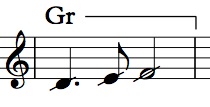A variety of “grind” or “scratch” tones can be achieved on bowed string instruments by using overpressure with the bow on the string. This can vary from sustained, strangled timbres where the resonance of the string is only slightly depressed, to subtones where the string is under so much pressure that it vibrates at a lower frequency than usual.[1]
An early example of a gesture which is often interpreted in HIP today as overpressure can be found in Biber’s 1669 work, Sonata Representativa (Biber, 1669/2004, p. 6), where it is used to depict a frog croaking.[2] However, the facsimile of this piece no longer exists, so it is no longer possible to ascertain whether this practice was indicated in Biber’s original notation.
Overpressure has been used frequently since the middle of the 20th century in repertoire for modern string instruments, including in works by composers such as Richard Barrett in his 1994 solo violin work, air, in George Crumb’s famous Black Angels (1970), and Helmut Lachenmann’s string quartets Gran Torso (1988, p. 1), “Reigen seliger Geister” (1989, p. 6) and Grido (2002, p. 5).
Overpressure on the baroque violin:
A wider timbral variation is possible to achieve on gut strings, in comparison to steel strings, when employing overpressure. This can vary from scratchy tones achieved nearer the bridge, to subtones achieved near the middle of the string. Rapid, machine gun-like overpressure, or as Michelle Lou terms it in her 2012 string quartet Porcupine, “Geiger Counter” (Lou, 2012, p. 4), is also possible to achieve on gut strings.
Overpressure has been used in several new works for the baroque violin commissioned by me from composers including Samuel Smith in archive (2017a), and Alexander Garsden in Law II (2013).
The following is an example of overpressure on each of the strings of the baroque violin.
Video example 8.1 – overpressure on each string of the baroque violin
The following is an example from bar 47 in archive by Samuel Smith (2017a, p. 2), showing a gradual movement from normal pressure, to slight overpressure, and back to normal pressure.
Video example 8.2 – overpressure in archive by Samuel Smith (2017a, p.2), bar 47
Figure 8.1 – archive by Samuel Smith (2017a, p.2), bar 47
The following is an example from bars 56-57 in Law II by Alexander Garsden (2013, p. 2), showing a movement from normal bow pressure to an accented grind sound.
Video example 8.3 – overpressure in Law II by Alexander Garsden (2013, p. 2), bars 56-57
Figure 8.2 – Law II by Alexander Garsden (2013. p.2), bars 56-57
Suggested notation:
A “slashed” notehead with “Gr” for “Grind” and a bracket over the relevant passage, as in Figure 8.3 below.
Figure 8.3 – example of a possible notation for an overpressure passage
If a variety of bow pressures is desired over a given passage, it may be preferable to notate shaded block graphics above the stave, as in Figure 8.1 above.
___________________________________________________________________________________________________
[1] For a detailed study of the function of sub tones on the modern violin, see violinist Mari Kimura’s website at http://www.marikimura.com/subharmonics.html
[2] For instance in Andrew Manze and Richard Egarr’s interpretation of this piece on their album Biber violin sonatas: Romanesca (Biber, 1994).


